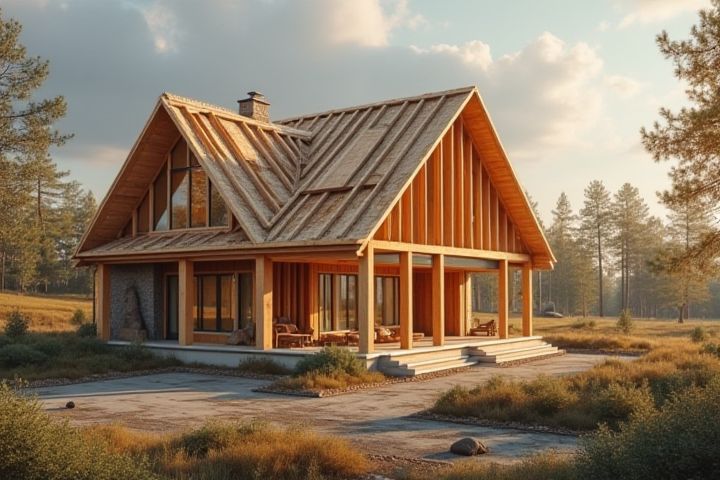
To make your house energy-efficient, start by upgrading insulation in walls, attics, and basements to prevent heat loss. Consider installing energy-efficient windows with low-emissivity (Low-E) coatings that reflect heat in summer and retain warmth in winter. Incorporate energy-efficient appliances, which are labeled with the ENERGY STAR certification, to reduce power consumption. Implement smart thermostats that learn your habits to optimize heating and cooling schedules. Finally, explore renewable energy sources like solar panels, which can significantly lower your utility bills while contributing to a sustainable lifestyle.
How To Make A House Energy-Efficient
Install energy-efficient windows
Installing energy-efficient windows is crucial for maximizing your home's thermal performance and reducing energy consumption. These windows feature low-emissivity (Low-E) coatings that minimize heat transfer and UV rays, effectively keeping your home cooler in summer and warmer in winter. By selecting double or triple-glazed options filled with argon or krypton gas, you can enhance insulation, which not only lowers energy bills but also increases comfort levels. When upgrading, consider your local climate and window orientation to optimize daylighting and energy efficiency, ensuring your investment pays off over time.
Use LED lighting
Switching to LED lighting significantly enhances your home's energy efficiency, as LEDs consume up to 75% less energy than traditional incandescent bulbs. These long-lasting bulbs not only reduce your electricity bills but also have a lifespan of around 25,000 hours, minimizing the frequency of replacements. Opting for smart LED options allows you to customize brightness levels and set schedules, further optimizing energy usage. By making this simple transition, you contribute to a sustainable environment while enjoying a well-lit and cost-effective living space.
Add insulation to walls and attics
Adding insulation to your walls and attic significantly enhances your home's energy efficiency by reducing heat transfer. Optimal insulation materials, such as fiberglass, foam boards, or spray foam, can minimize energy loss, keeping your living space comfortable throughout the year. Consider installing insulation with a high R-value, which indicates better thermal resistance, ensuring that cold air stays out in winter and cool air remains inside during summer. By upgrading your insulation, you lower energy consumption, subsequently decreasing utility bills and contributing to a more sustainable environment.
Seal air leaks
Sealing air leaks is crucial for enhancing your home's energy efficiency, as it minimizes unwanted drafts and heat loss. Begin by inspecting common leak areas, such as windows, doors, electrical outlets, and plumbing vents, where conditioned air can escape. Utilize caulk for stationary joints and weatherstripping for movable parts to create an airtight seal that improves insulation. By effectively sealing these leaks, you can reduce your heating and cooling costs, increase comfort levels, and decrease your overall environmental impact.
Upgrade to energy-efficient appliances
Upgrading to energy-efficient appliances can significantly reduce your household energy consumption by up to 30%. Look for appliances with the ENERGY STAR label, which indicates they meet strict energy efficiency guidelines set by the U.S. Environmental Protection Agency. By replacing old refrigerators, washing machines, and dishwashers with modern, energy-efficient models, you can save an average of $500 on utility bills annually. Investing in these appliances not only lowers your energy costs but also contributes to sustainability by minimizing your carbon footprint.
Install a programmable thermostat
Installing a programmable thermostat is a crucial step in enhancing your home's energy efficiency. This device allows you to set specific temperatures for different times of the day, optimizing heating and cooling usage based on your schedule. By reducing energy consumption during hours when you're away or asleep, you can significantly lower utility bills and minimize your carbon footprint. Ensure that your thermostat is compatible with your HVAC system, and consider features like Wi-Fi connectivity for remote access and monitoring via smartphone apps.
Use solar panels
Installing solar panels can significantly enhance your home's energy efficiency and reduce your electricity bills. Solar panels convert sunlight into electricity, allowing you to utilize renewable energy and lessen your dependence on non-renewable resources. By integrating energy storage systems, like batteries, you can store excess energy for nighttime use, maximizing your solar investment. Transitioning to solar energy not only saves you money in the long run but also contributes to reducing your carbon footprint, making your home more environmentally friendly.
Opt for a high-efficiency HVAC system
Choosing a high-efficiency HVAC system is crucial for enhancing your home's energy efficiency. Look for units with a high Seasonal Energy Efficiency Ratio (SEER) rating, as they consume less electricity while providing optimal heating and cooling. Regular maintenance, including filter changes and duct inspections, ensures that your system operates at peak performance, further reducing energy costs. Investing in a programmable thermostat can also maximize efficiency, allowing you to control temperatures based on your daily schedule, thus minimizing wasted energy.
Incorporate energy-efficient landscaping
Incorporating energy-efficient landscaping can significantly reduce your home's energy consumption and enhance its overall sustainability. Planting deciduous trees strategically around your property can provide natural shade during the summer months, lowering cooling costs by blocking direct sunlight from entering your home. Installing drought-resistant plants and native vegetation minimizes the need for irrigation, reducing water consumption and maintenance efforts. You can also utilize hardscapes like permeable pavements to manage stormwater runoff, contributing to the overall efficiency and ecological balance of your landscape design.
Implement smart home technology
Implementing smart home technology can significantly enhance your home's energy efficiency. Smart thermostats can adjust heating and cooling based on your schedule, potentially saving you up to 10-15% on energy bills. Smart lighting systems allow you to control lights remotely and set schedules, minimizing energy waste, with potential savings of 25-30% compared to traditional lighting. By utilizing energy monitoring devices, you can track and optimize energy use in real-time, empowering you to make informed decisions that lead to reduced consumption.
